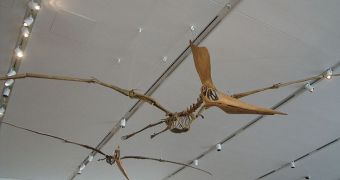According to new scientific evidence, it would appear that it was possible for ancient creatures called pterosaurs to fly for up to 10,000 miles without stop, many million years before jet flight was invented.
These animals were the rulers of the sky before the K-T extinction. The event took place some 65 million years ago, and wiped out all dinosaur species, paving the way for mammals to rule the land.
But, before that time, dinosaurs and pterosaurs were at the top of the food chain. Some of the largest early birds could apparently fly over incredibly-long distances without making a single stop.
Evidence to support this idea were presented on October 10, at the annual meeting of the Society for Vertebrate Paleontology, Wired reports.
The new investigation refers strictly to four species of so-called supergiant pterosaurs, which are the largest animals of their group. The species include Quetzalcoatlus northropi, a creature that was originally found in Texas.
The presentation was made by Chatham University in Pittsburgh biomechanist Michael Habib. He says that these creatures were the very best of the elite, being the incontestable masters of the air.
He explains that the largest pterosaurs have wings spanning an impressive 10 meters, or 33 feet, across, and that they were about as tall as a modern-day giraffe.
Such animals “are big by pterosaur standards. They are truly gruesomely huge by bird and bat standards,” the researcher explained for participants at the conference.
He explains that current estimates for the birds' body masses and wing sizes are still under discussion. However, if the number he proposes are true, then the pterosaur could make good use of thermals.
These are currents in the air that can help flying creatures, including modern birds, fly without actually flapping their wings. This allows them to remain airborne for prolonged periods of time.
Habib says that if this theory on how the pterosaurs looked like turn out to be true, than this “would make them the longest single-trip-distance fliers in the Earth’s history.”
There is also a new implication for the new findings, and namely the fact that pterosaur fossils discovered thousands of miles apart cannot be automatically considered new species.
“A pterosaur from Big Bend could be mating with a pterosaur from Transylvania,” the expert argued.

 14 DAY TRIAL //
14 DAY TRIAL //